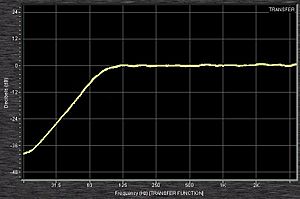Filter (electronics) facts for kids
Imagine a special kind of electronic circuit that helps clean up or change sounds and signals. These are called electronic filters. They can remove unwanted parts of a signal, like buzzing noises, or make the parts you want clearer and stronger. Think of them like a sieve for sounds or electrical signals!
Contents
What Are Electronic Filters?
Electronic filters are electrical circuits designed to work with signal processing. This means they can change an electrical signal in a specific way. Their main job is to let certain parts of a signal pass through while blocking or reducing other parts.
How Do Filters Work?
Signals, like sounds or radio waves, are made up of different frequency components. Frequency is how often something vibrates or repeats. For example, a deep bass sound has a low frequency, while a high-pitched whistle has a high frequency. Electronic filters can tell the difference between these frequencies and decide which ones to keep and which ones to block.
Different Kinds of Filters
There are many types of electronic filters, each designed for a different job. Here are some of the main ways we can group them:
Passive vs. Active Filters
- Passive filters are simpler. They are built using basic electronic parts like resistors, capacitors, and inductors. These filters don't need a separate power source to work.
- Active filters are more complex. They use parts like amplifiers (which need power) along with resistors and capacitors. Active filters can make a signal stronger and offer more control over how they work.
Analog vs. Digital Filters
- Analog filters work with analog signals, which are continuous, like the sound waves from your voice. Most older electronic devices use analog filters.
- Digital filters work with digital signals. These signals are made of numbers, like the music files on your phone or computer. Digital filters use special computer programs or chips to process the signals.
What Frequencies Do Filters Affect?
Filters are often named by which frequencies they allow to pass through.
High-Pass Filters
A high-pass filter lets high-frequency signals pass through easily, but it blocks or reduces low-frequency signals. Imagine a fence that only lets tall people (high frequencies) through, but stops short people (low frequencies).
Low-Pass Filters
A low-pass filter does the opposite of a high-pass filter. It lets low-frequency signals pass through easily, but it blocks or reduces high-frequency signals. This is like a fence that only lets short people (low frequencies) through.
Band-Pass Filters
A band-pass filter allows a specific range of frequencies to pass through while blocking both very low and very high frequencies. Think of it as a filter that only lets people of a certain height range pass. Radio tuners often use band-pass filters to pick out one radio station's frequency from many others.
Band-Stop Filters
A band-stop filter (also called a band-reject or notch filter) does the opposite of a band-pass filter. It blocks a specific range of frequencies but lets all other frequencies (both lower and higher) pass through. This is useful for removing a specific unwanted noise, like a hum, from a signal.
All-Pass Filters
An all-pass filter lets all frequencies pass through without changing their strength. However, it changes the "phase" of the signal, which can be used to create special sound effects or correct signal problems.
Where Are Filters Used?
Electronic filters are everywhere in our daily lives!
- In your radio or TV, they help you tune into a specific station or channel by blocking out other signals.
- In audio equipment like speakers, headphones, and music players, they help shape the sound, making bass deeper or treble clearer.
- In cell phones, they help separate your voice from background noise and manage different wireless signals.
- In medical devices, they can clean up signals from the body, like those from a heart monitor.
- In computer networks, they help manage data signals.
Most electronic filters you'll find are linear filters. This means they change the signal in a very predictable way. Digital filters often use a mathematical tool called a Fourier transform to help them understand and change the different frequencies in a signal.



